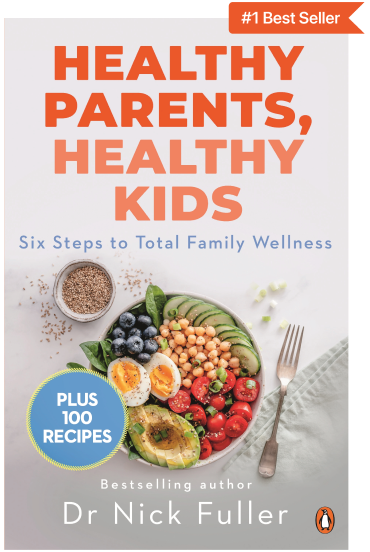My Kids Only Want Processed Foods. How Can I Get Them Eating Healthier, More Varied Meals?

Dr Nick Fuller
Leading Obesity Expert at the University of Sydney and founder of Interval Weight Loss.

If it feels like your child lives on chicken nuggets, sugary cereals, and snacks that could survive the end of the world, you’re not alone.
For many kids, packaged and processed foods aren’t just common; they’re often the only things they’ll agree to eat.
So why does this happen, and what can parents do to gently expand their child’s menu?
Why Processed Foods Dominate Kids’ Plates
Processed foods are any foods that have been changed from their original form.
Some processing is helpful, like pasteurising milk to make it safe, but ultra-processed foods are a different story. They’re manufactured using techniques that enhance flavour, texture, and longevity, and are usually loaded with added sugar, salt, unhealthy fats, and artificial ingredients.
Parents usually recognise the obvious culprits: fast food, chips, and sugary treats. But many ultra-processed foods sneak in under the guise of “healthy” snacks, like flavoured yoghurts, packaged muffins, or breakfast bars.
Because they offer little in the way of real nutrition, health experts advise keeping them to a minimum. Still, in Australia, these “discretionary foods” account for close to one-third of the daily energy intake for children.
What Makes Processed Foods So Irresistible to Kids?
Built-in biology
Ultra-processed foods are engineered to be irresistible. The added sugar, salt, and fat trigger the brain’s reward system, releasing feel-good chemicals that make kids want more.
Humans are naturally drawn to foods rich in sugar and fat, a survival trait from our hunter-gatherer ancestors, who needed high-energy foods to avoid starvation.
Fussy eating habits
About half of all children go through a fussy eating stage. This is another inherited survival mechanism: a natural caution against unfamiliar or bitter foods, which could have been poisonous.
Fussy eaters often stick to ultra-processed foods like chicken nuggets, chips, and sugary cereals because they’re predictable and safe. Their neutral colours and milder flavours resemble early foods like breastmilk and first solids, making them comforting rather than overwhelming for sensitive taste buds.
Marketing power
From clever YouTube ads to snacks displayed at eye level in supermarkets, kids are constantly exposed to marketing designed to make them crave and insist on ultra-processed foods.
How Processed Foods Affect Kids’ Health
Ultra-processed foods can influence children’s health in several ways, including:
- Nutritional gaps: Kids filling up on processed foods often miss out on vegetables, fruits, whole grains, and lean proteins, leading to diets low in fibre and other essential nutrients for growth.
- Childhood weight issues: Packed with calories, sugar, salt, and fat, and often served in large portions, ultra-processed foods encourage overeating and weight gain.
- Long-term risks: Regular consumption of ultra-processed foods is linked to chronic conditions like heart disease, type 2 diabetes, and certain cancers.
While unhealthy eating habits can be stubborn, positive changes in diet and lifestyle, even later in childhood, can help reverse some of these effects.
Science-Backed Strategies to Encourage Healthier Eating
Eat together
Family meals are a great way to model healthy eating. Sit down together, enjoy the same dishes, and put phones and tablets aside so everyone focuses on food and conversation.
Introduce new foods gradually
Kids usually need to try a new food several times, often eight to ten, before they’re willing to accept it. Offer them regularly, encourage tasting without pressure, and avoid using dessert as a reward, which can increase preference for treats. Serving meals when kids are slightly hungry (one to two hours after snacks) can also improve willingness to try new foods.
Add variety to familiar favourites
Kids are more open to new foods when they appear alongside something familiar. Try simple swaps, like lentils instead of beef in bolognese, roasted carrot “chips,” or grated veggies in sauces to gently expand their diet without overwhelming them.
Make meals fun
Visual appeal and playful presentation help kids enjoy healthy foods. Include different colours, textures, and shapes on the plate. Changing the location, like having an outdoor picnic, can also make mealtimes exciting and enjoyable.
Want some playful, pressure-free ways to bring joy to the table? Try these Educational Activities About Food For Picky Eaters to turn meals into food adventures.
Teach kids about the science of food
Helping children understand, in simple ways, where their food comes from can encourage healthier herbs and vegetables, while older kids can plant, water, and prune, giving them a hands-on connection to food.
- Explore it: Regular trips to the greengrocer, butcher, or fishmonger let children see, touch, and ask questions about healthy foods.
- Explain it: For younger kids, frame food in terms of energy: “Wholegrain toast helps you run and play longer.” With older kids, share fun facts, like “Fish contains omega-3 fats that help our brains work better.”
Involve kids in cooking
Getting children involved in meal prep makes them more curious about healthy foods. Let them pick recipes and take on simple tasks like stirring, chopping, or assembling ingredients.
When they help prepare meals, they feel proud of their contribution, and research shows this makes them more likely to eat what they’ve made.
Building new habits takes time, roughly two months, so expect some resistance. With consistency and patience, you can gradually shift their preferences from processed snacks to more nutritious foods, helping them develop lifelong healthy eating habits.
Wrapping Up
Kids are drawn to processed foods due to biology, fussy eating habits, and clever marketing. While these foods can affect nutrition and health, parents can encourage healthier choices through family meals, repeated gentle exposure to new foods, making meals fun, teaching about food, and involving children in cooking. With patience and consistency, these strategies can help children develop a more varied, nutritious diet and positive lifelong eating habits.
If your child leans heavily on packaged foods, making fresh options more appealing is key. These Innovative Salad Ideas for Kids That Make Veggies Fun show how simple tweaks can make healthy food exciting.
Stay ahead with current tips, professional advice, exclusive savings, and priority support!
Meet Dr Nick Fuller
My Story
As a father, I know first-hand that raising healthy and happy children is tricky. Children are fussy, particularly at the end of the day when they are shattered. We also live in a society where companies seek to profit from what we feed our kids; incorrect and damaging advice is pushed on us and marketed towards our children, and we have no time.
But with these recipes and resources, you and your children can enjoy simple and well-founded food and lifestyle choices for lifelong health.

About Dr Nick Fuller
Dr Nick Fuller is the founder of Interval Weight Loss and is a leading obesity expert at the University of Sydney with a Ph.D. in Obesity Treatment. Dr Fuller is also the author of three best-selling books and his work been published in top ranked journals in the medical field, including JAMA, Lancet and American Journal of Clinical Nutrition.
